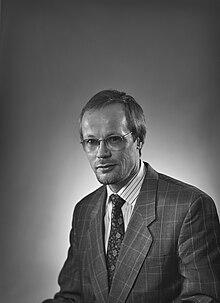Pekka Pyykkö

Veli Pekka Pyykkö (born 12 October 1941)[1] is a Finnish academic. He was professor of Chemistry at the University of Helsinki.[1] From 2009–2012, he was the chairman of the International Academy of Quantum Molecular Science. He is known for his extension to the periodic table of elements,[2][3] known as the Pyykkö model.[4]
Pyykkö model[]
After the 118 elements now known, Pekka Pyykkö predicts that the orbital shells will fill up in this order:
- 8s,
- 5g,
- the first two spaces of 8p,
- 6f,
- 7d,
- 9s,
- the first two spaces of 9p,
- the rest of 8p.[5]
He also suggests that period 8 be split into three parts:
- 8a, containing 8s,
- 8b, containing the first two elements of 8p,
- 8c, containing 7d and the rest of 8p.[5]
| Pyykkö model | ||||||||||||||||||||||||||||||||||||||||||||||||||
|---|---|---|---|---|---|---|---|---|---|---|---|---|---|---|---|---|---|---|---|---|---|---|---|---|---|---|---|---|---|---|---|---|---|---|---|---|---|---|---|---|---|---|---|---|---|---|---|---|---|---|
| Pyykkö-displaced elements are in boldface | ||||||||||||||||||||||||||||||||||||||||||||||||||
| 8 | 119 Uue |
120 Ubn |
121 Ubu |
122 Ubb |
123 Ubt |
124 Ubq |
125 Ubp |
126 Ubh |
127 Ubs |
128 Ubo |
129 Ube |
130 Utn |
131 Utu |
132 Utb |
133 Utt |
134 Utq |
135 Utp |
136 Uth |
137 Uts |
138 Uto |
141 Uqu |
142 Uqb |
143 Uqt |
144 Uqq |
145 Uqp |
146 Uqh |
147 Uqs |
148 Uqo |
149 Uqe |
150 Upn |
151 Upu |
152 Upb |
153 Upt |
154 Upq |
155 Upp |
156 Uph |
157 Ups |
158 Upo |
159 Upe |
160 Uhn |
161 Uhu |
162 Uhb |
163 Uht |
164 Uhq |
139 Ute |
140 Uqn |
169 Uhe |
170 Usn |
171 Usu |
172 Usb |
| 9 | 165 Uhp |
166 Uhh |
167 Uhs |
168 Uho | ||||||||||||||||||||||||||||||||||||||||||||||
| s-block | g-block | f-block | d-block | p-block | ||||||||||||||||||||||||||||||||||||||||||||||
The compact version:[5]

Pekka Pyykkö successfully predicted the possibility of a chemical bond between gold and the noble gas xenon, which is usually inert; this bond is known to occur in the cationic complex tetraxenonogold(II) (AuXe2+
4). He also successfully predicted the possibility of a gold–carbon triple bond.[6]
References[]
- ^ Jump up to: a b "Curriculum vitae". chem.helsinki.fi. 2012-04-25. Archived from the original on 2012-02-19. Retrieved 2012-05-28.
- ^ Roberts, Siobhan (27 August 2019). "Is It Time to Upend the Periodic Table?". The New York Times. Retrieved 7 December 2019.
- ^ Kean, Sam (30 January 2019). "A storied Russian lab is trying to push the periodic table past its limits—and uncover exotic new elements". Science. Retrieved 7 December 2019.
- ^ Atsumi, Michiko (2013). "SCCJ Cafe -Season 3-Theoretical Chemistry in Nordic (2)"The Extended Periodic Table − Pyykkö Model"". Journal of Computer Chemistry, Japan. 12 (2): A18–A20. doi:10.2477/jccj.2013-0008.
- ^ Jump up to: a b c Pyykkö, Pekka (2011). "A suggested periodic table up to Z≤ 172, based on Dirac–Fock calculations on atoms and ions". Physical Chemistry Chemical Physics. 13 (1): 161–8. Bibcode:2011PCCP...13..161P. doi:10.1039/c0cp01575j. PMID 20967377.
- ^ Scientific American June 2013, "Cracks in the Periodic Table". p. 72.
- 1941 births
- Living people
- People involved with the periodic table
- Academics of the University of Helsinki
- Finnish chemists
- Schrödinger Medal recipients
- Computational chemists
- Finnish scientist stubs
- Chemist stubs